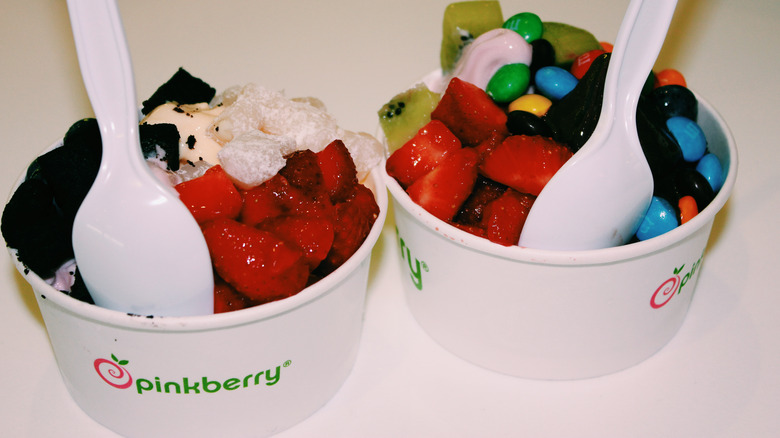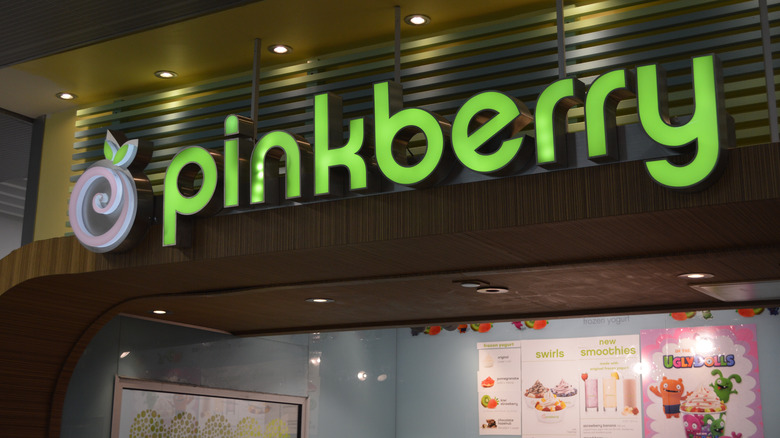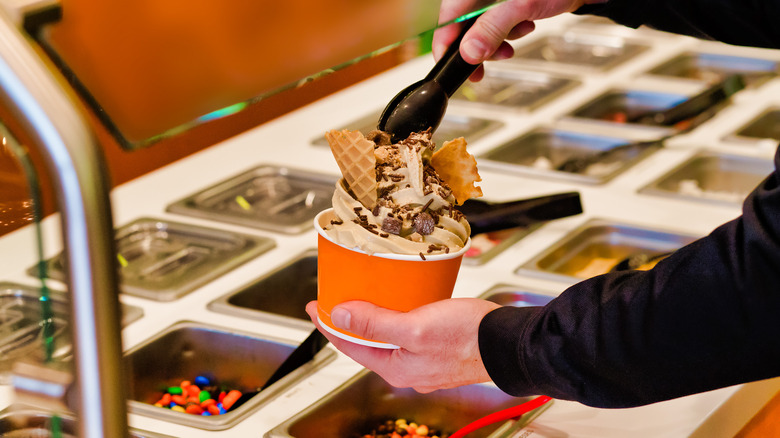Why Frozen Yogurt Chains Are Closing Down
Avocado toast, fondue, kale, quinoa, sriracha, Crock-Pot meals, spiked seltzers, smoothies, Pumpkin Spice Lattes, craft beer ... food and beverage items can experience sudden surges in popularity, even if they've been around for a while. Some prove to be fads that fade into obscurity, while others have real staying power. Centuries-old Japanese sushi, for instance, first started to become a hit in Los Angeles by the late 1960s, particularly among celebrities, explains Food52. The following decades saw a massive increase in the number of sushi restaurants in cities across America, and the dish remains a fixture on the U.S. food scene to this day.
By the 2010s, it seemed as though a ubiquitous dessert item billed as a better-for-you alternative to ice cream, was headed toward a similar trajectory. Frozen yogurt sweetened with milk and sugar had its heyday in the 1980s. But when Pinkberry opened in West Hollywood in 2005, it became an instant success — pulling in droves of customers with its brightly colored interior, self-serve containers, and huge assortment of toppings. Celebrities including Charlize Theron, Oprah Winfrey, and David Beckham were photographed with Pinkberry cups, and copycat stores began to spring up across Southern California and beyond (per Taste Cooking).
Eat This, Not That! reports that the number of froyo stores doubled from 2009 to 2014. By 2015, as many as 2,896 had opened in the United States, according to Guidant Financial. However, in the years since, froyo's popularity has started to decline as precipitously as it surged.
Customers are saying no to froyo
In recent years, frozen yogurt shops have shuttered in droves across the United States. According to Restaurant Business (via Eat This, Not That!), Pinkberry closed 74 of its locations from 2014 to 2018. The company now operates around half the number of stores that were open during the height of its popularity, ETNT notes. And as of September, all of Pinkberry's New Orleans locations will be closed, per Biz New Orleans.
To understand the fluctuations in customers' demand for froyo, it's important to examine how the dessert maps onto diet trends in America. Frozen yogurt first rode the low-fat diet wave in the 1980s. It managed to recapture that success in the early to mid-2000s with marketing that touted the health benefits of yogurt's probiotics and framed the product as a healthier alternative to ice cream. However, over time (and partially due to the abundance of sugary toppings offered by froyo stores), customers began to lose confidence in the industry's health-related claims, explains Taste Cooking.
Another blow came with the rise of dairy-free and vegan diets around 2015, as well as the emergence of low-calorie ice cream alternatives such as Halo Top, which was founded in 2012. Finally, another factor — one that has nothing to do with diet trends or health claims — is that a lot of people, particularly kids, just don't enjoy frozen yogurt's tart flavor. Perhaps we didn't need a froyo shop on every corner to meet customers' demand for the product.
Pinkberry isn't the only froyo chain feeling the pinch
While Pinkberry's stores have been steadily closing in recent years, other froyo chains haven't been doing so well, either. As of 2020, there were 2,552 locations of chain froyo shops in the United States; in 2018, there had been 3,020, per a report from The International Frozen Yogurt Association. According to the organization, Menchie's saw the greatest number of store closures in 2020; other chains, such as Yogurtland, saw store closures as well. And overall, dozens of froyo store locations closed because of the coronavirus pandemic. (Still, the industry faced decline before the pandemic; a 2015 headline in the New York Business Journal asked, "Are we witnessing the fall of frozen yogurt in NYC?")
In addition to the reports of store closures, a 2019 report from the USDA's Economic Research Service noted that between 2000 and 2018, the United States' production of frozen yogurt had decreased by 47%. The USDA's report also cites the "increased availability of non-dairy ice cream options" as a potential reason for froyo's decline in popularity.
However, there's still at least some demand for the topping-laden frozen dairy treat. The International Frozen Yogurt Association also points out that Yogen Fruz and Llaollao grew during the COVID-19 pandemic. And a separate report from the organization noted that in January, seven new froyo shops opened across the United States, compared with three that had closed. Froyo may be on the decline, but the industry isn't dead just yet.


